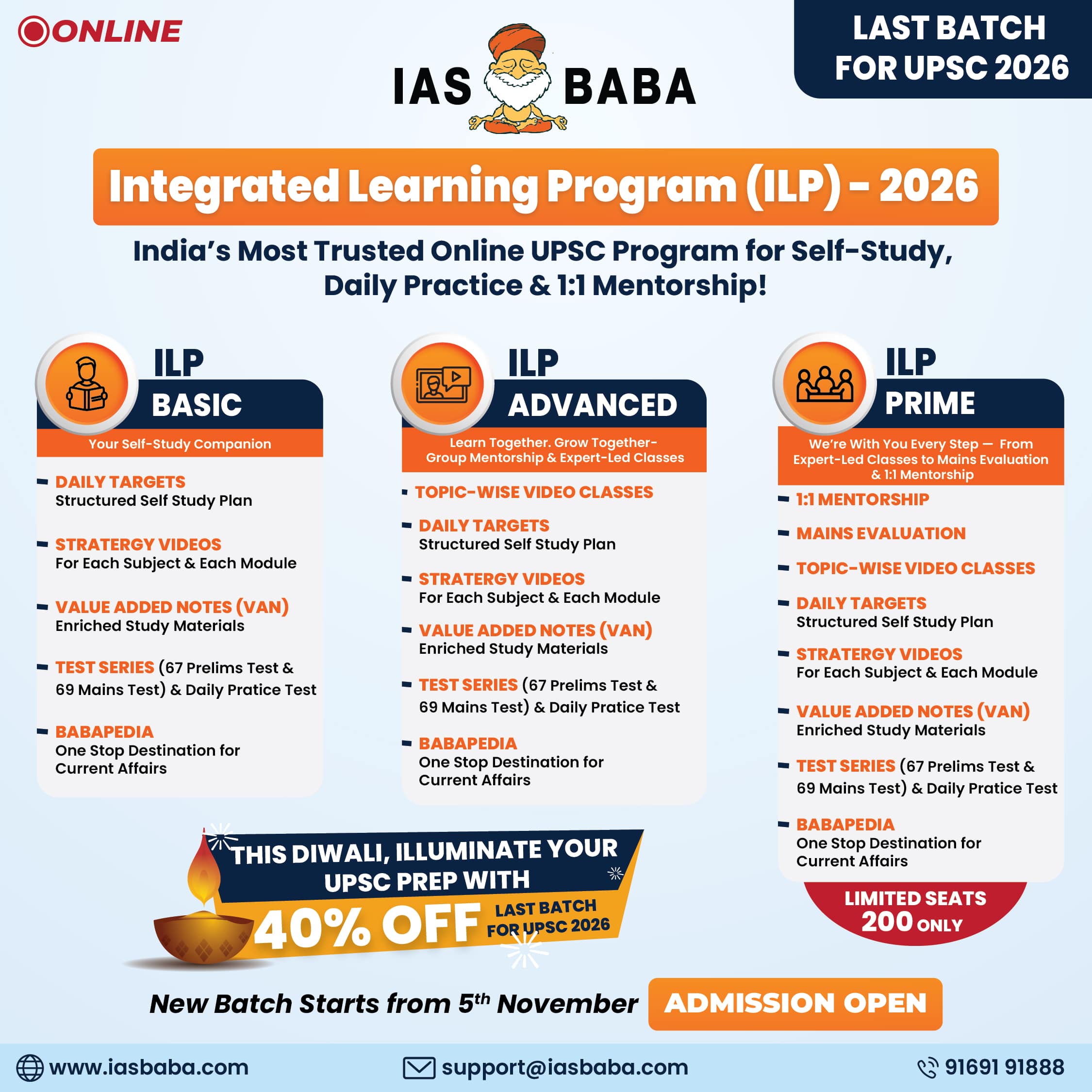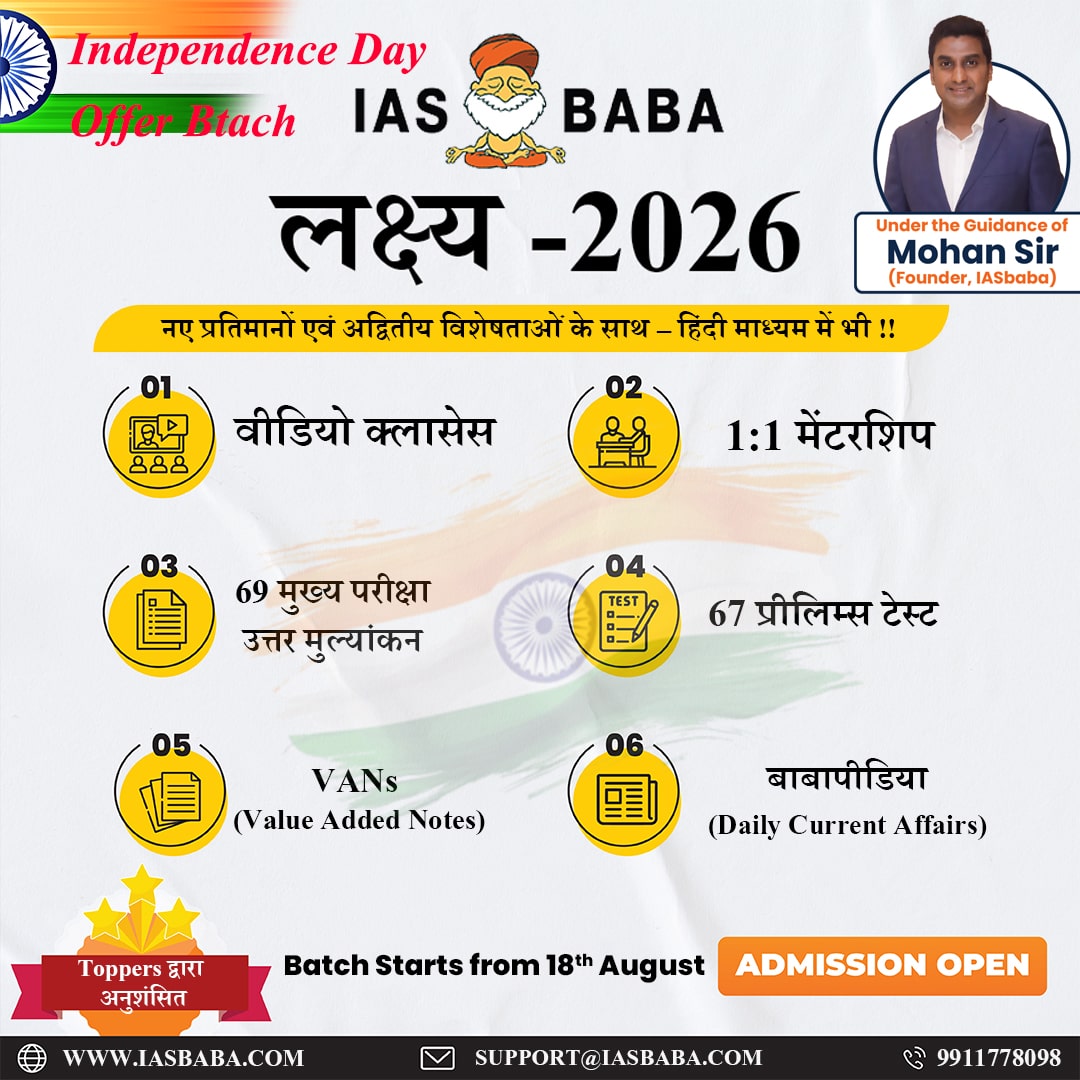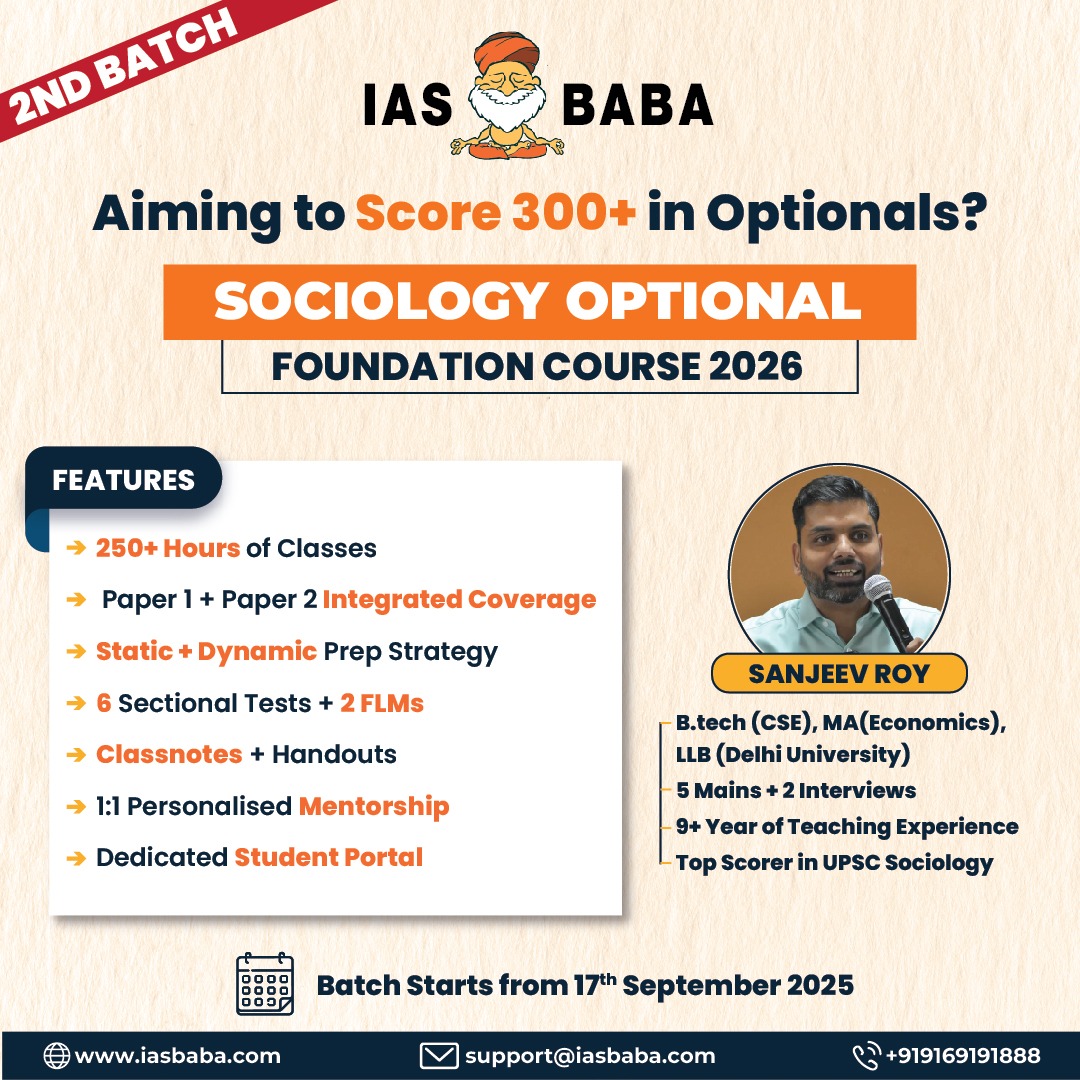IASbaba's Daily Current Affairs Analysis
Archives
(PRELIMS Focus)
Category: Environment and Ecology.
Context:
- There is a need to increase carbon sequestration in the soil, which is 0.15% at present against the preferred figure of 2% to 5 %, Sultan Ahmed Ismail, Member, State Planning Commission, said.

About Carbon Sequestration:
- Definition: Carbon sequestration is the long-term storage of carbon in plants, soils, geologic formations, and the ocean. It occurs both naturally and as a result of anthropogenic activities and typically refers to the storage of carbon.
- Significance: Carbon Farming (Carbon Sequestration) involves practices that are known to improve the rate at which CO2 is removed from the atmosphere and converted to plant material and soil organic matter. It promises a bold new agricultural business model — one that fights climate change, creates jobs, and saves farms that might otherwise be unprofitable.
- Important for SDGs: Sustainable Development Goal 13 (SDG 13: Climate Action), which focuses on taking immediate action to address climate change and its effects, is in line with research into carbon sequestration.
- Types of Carbon Sequestration:
- Terrestrial Carbon Sequestration: It is the process through which CO2 from the atmosphere is absorbed by trees and plants through photosynthesis and stored as carbon in soils and biomass (tree trunks, branches, foliage, and roots)
- Geologic Carbon Sequestration: Under this, CO2 is stored in areas such as oil reservoirs, gas reservoirs, unmineable coal seams, saline formations and shale formations with high organic content.
- Ocean Carbon Sequestration: Under this, oceans absorb, release and store large amounts of CO2 from the atmosphere. This can be done in two ways- enhancing productivity of ocean biological systems through Iron fertilization, and injecting CO2 into the deep ocean.
- Different Methods of Carbon Sequestration:
- Natural Carbon Sequestration: It is the process by which nature has achieved a balance of carbon dioxide in our atmosphere suitable for sustaining life. All organic life on this planet is carbon based and when plants and animals die, much of the carbon goes back into the ground where it has little impact on contributing to global warming.
- Artificial Carbon Sequestration: It refers to a number of processes whereby carbon emissions are captured at the point of production (e.g., Factory Chimneys) and then buried. One example is ocean sequestration whereby carbon dioxide is injected deep into the ocean, forming lakes of CO2.
Source:
Category: Defence and Security
Context:
- China has commissioned its latest aircraft carrier Fujian after extensive sea trials, state media reported.

About Fujian Aircraft Carrier:
- Nature: The Fujian is China’s third carrier and the first that it both designed and built itself.
- First two carriers: China’s first aircraft carrier, the Liaoning, was Soviet-made and its second, the Shandong, was built in China but based on the Soviet model. Both use older-style ski-jump type systems to help planes take flight.
- In sync with objective of a modernised force by 2035: It is perhaps the most visible example of China’s massive military overhaul and expansion that aims to have a modernised force by 2035 and one that is “world class” by mid-century.
- Significance: For China’s navy, one goal is to dominate the near waters of the South China Sea, East China Sea and Yellow Sea around the so-called First Island Chain, which runs south through Japan, Taiwan and the Philippines. But deeper into the Pacific, it also wants to be able to contest control of the Second Island Chain, where the U.S. has important military facilities on Guam and elsewhere.
- Technology used: The Fujian skips past the steam catapult technology used on most American carriers to employ an electromagnetic launch system found only on the latest U.S. Navy Ford-class carriers. The system causes less stress to the aircraft and the ship, allows for more precise control over speed and can launch a wider range of aircraft than the steam system.
- Comparison to carriers of US: Numerically it only has three carriers compared to the U.S. Navy’s 11, and while China’s carriers are all conventionally powered, the U.S.’s are all nuclear powered — they can operate almost indefinitely without being refuelled, increasing their range.
- Aircraft carriers of India: The Indian Navy operates two aircraft carriers namely the INS Vikramaditya, a refurbished Russian carrier commissioned in 2013, and the INS Vikrant, an indigenously designed and built carrier commissioned in 2022.
Source:
Category: ScHistory and Culture
Context:
- President Droupadi Murmu has extended her greetings on the occasion of the historic ‘Baliyatra’ festival to all the countrymen, especially the people of Odisha.

About Baliyatra Festival:
- Nomenclature: Baliyatra, literally ‘voyage to Bali’ is one of the country’s largest open-air fares.
- Location: It is celebrated annually in Cuttack, Odisha.
- Occasion: It is celebrated every year on Kartika Purnima (full moon night in the month of Kartik) that marks the day that the seafaring traders departed for the Indonesian islands.
- Reason behind festival: It is organised every year to commemorate the 2,000-year-old maritime and cultural links between ancient Kalinga (today’s Odisha) and Bali and other South and Southeast Asian regions like Java, Sumatra, Borneo, Burma (Myanmar) and Ceylon (Sri Lanka).
- Significance: The Bali Yatra celebrates the ingenuity and skill of those expert sailors who made Kalinga one of the most prosperous empires of its time. It is a time when people purchase everything from automobiles and electronic devices to local artisanal products at prices that are comparatively low.
- Methods of celebration: The celebration features grand fairs, elaborate rides, food and dance. Indian women perform ‘Boita Bandana’, they make boats of paper or banana leaf (sholapith) with lighted lamps inside and float them down the Mahanadi as a part of the celebrations.
Source:
Category: Science and Technology
Context:
- With Project Suncatcher, Google joins the club to put AI data centres in space, but feasibility remains a challenge.

About Project Suncatcher:
- Nature: Called Project Suncatcher, Google’s new moonshot is a research initiative exploring how constellations of solar-powered satellites could host data centres in space. The idea is similar to satellite constellations like Starlink, which provide high-speed internet services from space via thousands of orbiting satellites.
- Objective: Project Suncatcher envisions solar-powered satellites hosting AI data centres in space to reduce Earth’s energy and water consumption used for cooling terrestrial facilities.
- Mechanism: The satellites will rely on solar energy and optical data transmission to function as a cohesive high-performance computing network. TPUs (Trillium v6e) are being tested for radiation resistance and performance in extreme conditions.
- Expected launch: Google plans to launch two prototype satellites by early 2027 to test its space-based TPU (Tensor Processing Unit) hardware.
- Significance: The cost of electricity on Earth is a major challenge for powering data centres in the long run, and deploying solar panels on the surface wouldn’t be very effective. However, in space, solar panels can be up to eight times more efficient than they are on Earth. The combination of uninterrupted sunlight and higher efficiency means significantly more power available for data processing.
Source:
Category: Polity and Governance
Context:
- Over the years, the National Cooperative Development Corporation (NCDC) has demonstrated a strong and sustained commitment to strengthening India’s cooperative ecosystem through continuous financial support.

About National Cooperative Development Corporation (NCDC):
- Nature: NCDC is a statutory body that promotes and finances cooperative development in agriculture, rural industries, and allied sectors.
- Establishment: It was set up in 1963 under an Act of Parliament and functions under the Ministry of Cooperation.
- Headquarters: It is based in New Delhi, with 18 regional and state offices across India.
- Objective: It promotes self-reliant and sustainable cooperatives in agriculture and rural industries and enables cooperatives to access long-term credit, working capital, and modern infrastructure.
- Major functions:
- It finances production, processing, marketing, and storage of agricultural produce. It also supports import and export of notified commodities such as fertilizers, machinery, rubber, textiles, etc.
- It funds income-generating activities like dairy, poultry, fisheries, handloom, and sericulture. It also extends financial assistance to cooperatives for rural infrastructure such as irrigation, sanitation, and animal health.
- It provides both grants and loans to State Governments and directly to eligible cooperative societies. It also offers technical guidance and project preparation support through its regional offices.
- Significance of NCDC:
- It serves over 13,000 cooperative societies with 2.9 crore members.
- It enables inclusive rural growth through job creation, especially in women-led and labour cooperatives.
- It supports cooperatives in cold storage, food processing, fisheries, dairy, and textiles, enhancing value chains.
Source:
(MAINS Focus)
(GS Paper 3 – Indian Economy: Monetary Policy, External Sector, Exchange Rate Management)
Context (Introduction)
The Indian rupee has fallen sharply by over 6% between February and October 2025, even as the U.S. dollar weakened globally. The RBI’s restrained response, despite holding substantial reserves, raises questions about India’s exchange rate management and macroeconomic priorities.
Main Arguments
- Accelerated Depreciation and Global Divergence: The rupee’s recent sharp fall marks an accelerated depreciation, diverging from the trend of other emerging Asian currencies that have stabilised or appreciated, even as the U.S. dollar weakened against major currencies like the euro and pound.
- Trade Impact of U.S. Tariffs: The U.S. has imposed 50% tariffs on Indian imports — far higher than the 10–20% faced by competitors — undermining export competitiveness and forex inflows. Though India’s export dependence is lower, the move has dented investor confidence and market sentiment.
- Portfolio Outflows and Investor Sentiment: After years of strong portfolio inflows, India saw nearly $2 billion in outflows in 2025 amid global uncertainty. Fears of further depreciation have triggered a self-reinforcing cycle of risk aversion and capital flight.
- Reduced RBI Intervention: The RBI has curtailed its dollar sales — from $57 billion (Oct 2024–Feb 2025) to $8 billion (Mar–Jul 2025) — signalling a shift toward conserving reserves and allowing market-driven adjustment rather than defending a specific rate.
- Reserve Depletion and Balance of Payments Concerns:
-
-
- Widening Current Account Deficit: Rising imports and tariff-hit exports are expanding the CAD.
- Falling Services & Remittance Inflows: Higher H-1B visa fees and curbs on IT services threaten inflows that previously financed most of India’s trade deficit, heightening balance of payments risks.
-
- Capital Flow Uncertainty and Speculative Pressure: With global volatility and the reversal of “footloose” capital, the RBI appears to be conserving reserves to withstand potential speculative attacks or sharper future volatility rather than expending them now with limited stabilising effect.
Criticisms / Drawbacks
- Policy Ambiguity and Communication Gap: The RBI’s silence has bred confusion. Unlike earlier interventions that reassured markets, the current opacity on its objectives — whether defending reserves or letting the rupee adjust — has amplified speculative behaviour.
- Imported Inflation and Cost-of-Living Pressure: A depreciating rupee raises the domestic cost of imported oil, fertilizers, and industrial inputs, feeding into headline inflation. This erodes household purchasing power and complicates monetary policy trade-offs.
- Fiscal Stress and External Vulnerability: Higher import costs increase subsidy burdens and widen the fiscal deficit. For an economy already grappling with slowing consumption and a large public debt, this can strain fiscal sustainability and credit ratings.
- Competitive Disadvantage vis-à-vis Peers: While other Asian economies have managed to maintain stable currencies, India’s steeper fall could deter foreign investors, who may see the rupee as riskier than regional alternatives. This affects capital inflows and business confidence.
- Short-Term Gains, Long-Term Risks: Even if depreciation improves export competitiveness, its benefits are temporary. Exporters dependent on imported inputs gain little. Sustained currency weakness could raise India’s external debt servicing burden, given that nearly 50% of corporate external borrowings are dollar-denominated.
Reforms and Way Forward
- Transparent Forex Policy Framework: The RBI should articulate a clear communication strategy outlining conditions under which it will intervene. Predictable policy guidance enhances investor confidence and reduces market speculation.
- Diversification of Export Basket: Reducing dependence on the U.S. market by diversifying export destinations and sectors is crucial. Expanding trade within Asia, Africa, and Latin America can reduce vulnerability to U.S. tariffs and global shocks.
- Boosting Non-Debt Capital Inflows: Encouraging FDI in manufacturing and renewable energy can provide stable foreign exchange sources. Policies like the Production-Linked Incentive (PLI) Scheme should be expanded with ease of doing business reforms to attract long-term investors.
- Strengthening Domestic Demand and Productivity: Exchange rate management cannot substitute for structural reforms. Improving logistics efficiency, reducing import dependence in energy and electronics, and supporting domestic innovation are key to real competitiveness.
- Calibrated Use of Forex Reserves: India’s reserves, though large, are finite. A rule-based intervention policy — intervening only to counter volatility, not to fix a target level — would preserve reserves while maintaining market confidence.
- Strengthening External Sector Resilience: Promoting local currency settlement mechanisms, expanding the use of Indian Rupee in international trade, and pursuing currency swap agreements with major trading partners can reduce dollar dependence.
- Policy Coordination: Fiscal and monetary authorities must coordinate. Exchange rate management, inflation control, and capital flow regulation require integrated action to prevent conflicting signals to markets.
Conclusion
A transparent, rules-based exchange rate policy, coupled with structural reforms to boost export capacity and reduce import dependence, is essential to ensure external stability. In the long run, confidence, not control, must anchor India’s currency policy.
UPSC Mains Practice Question
- “Monetary policy serves as the first line of defence against inflation and currency volatility.” Discuss the role of the Reserve Bank of India in controlling inflation and stabilising the rupee, highlighting the key policy instruments at its disposal. (15 marks, 250 words)
Source: The Frontline
(GS Paper 1 – Indian Society: Social Empowerment)
Context (Introduction)
The year 2025 marks 100 years of the Self-Respect Movement launched by E.V. Ramasamy Periyar in Tamil Nadu. The movement, rooted in rationalism and equality, transformed India’s discourse on caste, gender, and identity, laying the foundation for Dravidian politics and modern social justice.
Main Arguments
- Origins and Philosophy
- The Self-Respect Movement (1925) arose in colonial Tamil society marked by Brahmin dominance, caste rigidity, and gender inequality.
- Periyar, disillusioned by the Congress’s indifference to caste issues, envisioned a movement of social self-determination — reclaiming dignity (suyamariyadhai) for the oppressed.
- Its philosophical base combined rationalism, humanism, and social equality, challenging religion-sanctioned hierarchies.
- Influenced by Iyothee Thass’s anti-caste writings and Ataturk’s secularism, Periyar sought not political independence first, but freedom from social slavery.
- Aims and Core Tenets
- Annihilation of Caste (Jaathi Ozhippu):
- Called for the destruction of caste-based birth privileges and priestly authority.
- Promoted inter-caste dining and marriage, temple entry for all, and equal respect for all professions.
- Influenced Ambedkar’s later call for “caste annihilation”, reflecting convergent reformist ideals.
- Women’s Liberation (Penn Viduthalai):
- Advocated equal rights in education, marriage, and property.
- Opposed child marriage, dowry, and female chastity norms (karpu).
- Women activists like Nagammai and Moovalur Ramamirtham Ammaiyar led campaigns for widow remarriage and reproductive rights.
- Rationalism (Pagutharivu):
- Encouraged questioning of blind faith, rituals, astrology, and religious dogma.
- Used public lectures and journals (Kudi Arasu) to promote scientific temper and moral reasoning.
- Emphasized “reason over religion” as the path to equality — later echoed in Article 51A(h) of the Indian Constitution.
- Social Equality (Samathuvam):
- Sought a society without caste, gender, or class distinctions.
- Rejected Sanskritisation as a means of upliftment and instead promoted Tamil identity and Dravidian culture as tools of self-respect.
- Impact and Legacy
- Social Impact
- Democratisation of Tamil Society: The movement broke traditional barriers between upper and lower castes through community reforms and public inter-caste marriages.
- Rise of Rational Discourse: Created a shift from ritual-based religion to reason-based ethics; influenced later reformists and educators.
- Empowerment of Marginalised Castes: For the first time, non-Brahmin voices gained ideological legitimacy in social and cultural life.
- Political Impact
- Dravidian Ideology: The movement gave birth to the Justice Party (later Dravidar Kazhagam) and influenced DMK and AIADMK, embedding social justice, welfare, and linguistic pride in Tamil politics.
- Reservation and Affirmative Action: Laid the foundation for communal representation (1921 Madras G.O.), influencing later Mandal policies nationwide.
- Model of Social Democracy: Tamil Nadu’s progressive social indicators — literacy, women’s empowerment, low fertility, and caste mobility — reflect Periyar’s social model in governance.
- Gender and Cultural Impact
- The movement redefined womanhood beyond domesticity — promoting female public participation and education.
- Encouraged women to preside over public meetings, a rare phenomenon in 1930s India.
- Challenged Sanskritic patriarchy and legitimised Tamil feminist expression through print media and theatre.
- Intellectual and National Influence
- The idea of self-respect transcended Tamil Nadu, resonating with Ambedkarite and socialist movements in western and northern India.
- Influenced the language of constitutional morality, rational thought, and secular citizenship post-1947.
- Inspired leaders like Ram Manohar Lohia and Jyotirao Phule’s followers who connected caste and economic injustice.
Criticisms and Limitations
- Excessive Anti-Religious Tone: Periyar’s militant atheism alienated moderate believers and limited wider social appeal.
- Neglect of Class and Economic Issues: Critics argue that caste and gender were prioritised over economic redistribution.
- Dravidian Political Dilution: Later political offshoots diluted Periyar’s radical egalitarianism, turning reform into vote-based populism.
- Limited Pan-Indian Penetration: The movement remained largely regional due to its linguistic and cultural framing.
Conclusion
The Self-Respect Movement was not merely a Tamil social reform; it was a revolution in human dignity. By replacing ritual with reason and hierarchy with equality, Periyar redefined the meaning of freedom in India.
Its impact—visible in affirmative action, women’s emancipation, and rationalist education—continues to shape India’s democratic ethos. Yet, caste and gender inequities remind us that the struggle for suyamariyadhai (self-respect) remains incomplete.
In essence, Periyar’s century-old call still echoes: “Without self-respect, self-rule is meaningless.”
UPSC Mains Practice Question
- “The Self-Respect Movement was not just a challenge to caste, but a redefinition of human dignity.” Discuss its evolution and impact on Indian society. (15 marks, 250 words)
Source: The Frontline













